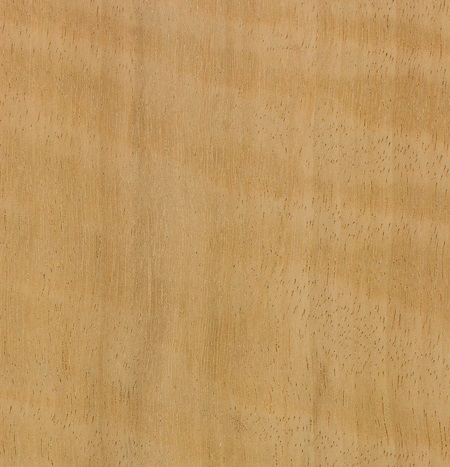Movingui

| Common Name | Movingui, ayan, Nigerian satinwood |
| Scientific Name: | Distemonanthus benthamianus |
| Distribution: | West Africa |
| Tree Size | 100-125 ft (30-38 m) tall, 3-5 ft (1-1.5 m) trunk diameter |
| Average Dried Weight | 45.1 lbs/ft3 (720 kg/m3) |
| Specific Gravity (Basic, 12% MC) | 0.58, 0.72 |
| Janka Hardness | 1,280 lbf (5,680 N) |
| Modulus of Rupture | 18,740 lbf/in2 (129.2 MPa) |
| Elastic Modulus | 1,773,000 lbf/in2 (12.23 GPa) |
| Crushing Strength | 8,890 lbf/in2 (61.3 MPa) |
| Shrinkage | Radial: 3.5%, Tangential: 5.7%, Volumetric: 10.0%, T/R Ratio: 1.6 |
Color/Appearance : Yellow to orangish brown, darkening with age. Frequently exhibits figured grain patterns such as mottle or curl.
Grain/Texture : Grain can vary from straight to interlocked to wavy. Texture is fine and even, with a good natural luster.
Rot Resistance : Rated as moderately durable; moderate termite resistance.
Workability : Generally the wood is easy to work, though movingui can have up to 1.3% silica content by weight, which may result in moderate to severe blunting effects. Quartersawn surfaces are inclined to tearout during planing, and charring of the wood may occur during drilling. Movingui glues, stains, and finishes well. Responds moderately well to steam bending.
Odor : Movingui has a mild odor when being worked.
Allergies/Toxicity : Although severe reactions are quite uncommon, movingui has been reported to cause skin irritation. See the articles Wood Allergies and Toxicity and Wood Dust Safety for more information.
Pricing/Availability : Usually available as veneer; solid lumber is also occasionally available. Cost is in the mid to upper range for an imported hardwood, with higher prices for figured pieces.
Sustainability : This wood species is not listed in the CITES Appendices, and is reported by the IUCN as being a species of least concern.
Common Uses : Veneer, cabinetry, furniture, and flooring.
Comments : As with so many other lustrous, yellow-colored woods, movingui is frequently referred to as satinwood—more specifically, Nigerian satinwood. However, the satinwood moniker is properly reserved for Chloroxylon swietenia and Zanthoxylum flavum.
